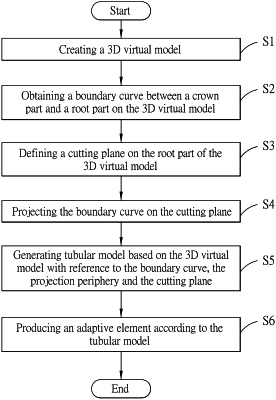| CPC A61C 8/005 (2013.01) [A61B 6/032 (2013.01); A61B 6/14 (2013.01); A61B 6/4085 (2013.01); A61C 8/0045 (2013.01); A61C 8/008 (2013.01); A61C 9/0046 (2013.01); A61C 13/0004 (2013.01); A61C 13/0019 (2013.01)] | 10 Claims |

|
1. A method for producing an adaptive element for dental implantation, comprising steps of:
creating, by a model creating equipment, a three-dimensional (3D) virtual model of a target tooth of a patient, the 3D virtual model including a crown part and a root part connected to the crown part, the target tooth being a to-be-treated tooth on a side of the patient's mouth, or a symmetric tooth located on another side of the patient's mouth;
obtaining, by a processing device, a boundary curve between the crown part and the root part on the 3D virtual model of the target tooth;
defining, by the processing device, a boundary plane on the root part of the 3D virtual model of the target tooth in a manner that the boundary plane is perpendicular to a vertical axis of the 3D virtual model and is spaced apart from the boundary curve;
projecting, by the processing device, the boundary curve on the boundary plane in a direction parallel to the vertical axis;
generating, by the processing device, a tubular model having a predetermined thickness based on the boundary curve, a virtual surface connected from the boundary curve to the boundary plane, and the boundary plane; and
producing, by a 3D forming equipment, the adaptive element according to the tubular model,
wherein the step of defining the boundary plane includes:
defining, as the boundary plane, a plane that is parallel to and spaced apart by a predetermined distance (h) from a tangent line touching a reference point of the boundary curve and that is perpendicular to the vertical axis, wherein the reference point is an extremity of the boundary curve of the 3D virtual model;
wherein the virtual surface connected from the boundary curve to the boundary plane is defined as a projection periphery;
wherein, in the step of generating the tubular model, the tubular model is created based on the projection periphery that defines a surrounding wall surrounding a central axis of the tubular model, the boundary plane that defines an opening end of the tubular model, and the boundary curve that defines another opening end of the tubular model.
|